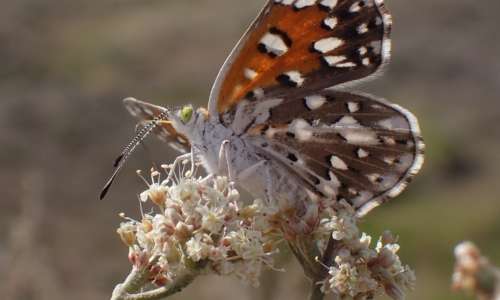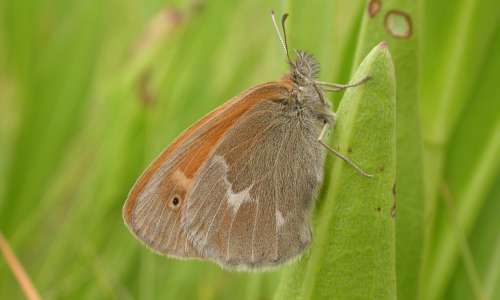We are the voices of change
Introducing P2C's new campaign "Wings of Hope".
As of today, more than 20 species of butterflies are listed under the Species at Risk Act (SARA) as "Endangered", "Threatened" or even "Extirpated".
Wings of Hope is a call to come together and support pollinator populations across the country and to bring a message of hope: together we can be the voices of change.
For the 2024 campaign, butterflies are in the spotlight! Discover the incredible migration of monarch butterflies with Dani. This female monarch will make you discover her incredible odyssey and the history and daily life of other species of butterflies who are not all lucky enough to be in the spotlight!
Wings of Hope celebrates those who want to make a difference for pollinators and the Earth! We wish you a good trip!

Meet Dani:
Dani Plexippus is a representative from all the endangered and vulnerable butterfly species in Canada. She is the voice of Hope, while doing her incredible migration from Canada to Mexico, where she will overwinter.
Dani is a female born in Ontario who is also a member of the Super Generation of monarch butterfly, that will do the journey in only one generation, travelling for over 5,000 km.
Like most female monarch butterflies, Dani has a wingspan of 8 cm and can be distinguished from males by the two missing black spot on the surface of the hindwings in comparaison to the males of her species.
Dani loves the nectar of a wide variety of flowers including Canada goldenrod (Solidago canadensis) and will consume a lot of it to build up fat reserve and be able to do her long migration. At then end of the winter, when she will leave Mexico, Dani will lay her eggs on milkweed as her larvae will feed exclusively on the leaves which we help them get their colorful bright colors and make them poisonous to scare away potential predators.
Unfortunately, since 2023, Monarch butterflies have been recognized and listed by the Government of Canada as "Endangered" under the federal Species at Risk Act (SARA). Check out the "Threats" section to know why.
About Her Journey
At the end of summer, when the days are getting shorter and the temperatures colder, Dani and the other monarch butterflies living in Canada will leave and start their long adventure.
Monarch butterflies start their 5,000 km journey south at the end of August/beginning of September. Their final destination is in a forest, somewhere in the Transvolcanic mountains of central Mexico where millions of adults will gather on oyamel trees to overwinter.
But how do Dani and her friends know where they are going? How do they know when to leave? Or why do they are different from the other generations of monarchs? Click on the images below to learn more!
The Threats and Challenges
On her journey and throughout her lives, Dani will face many challenges and difficulties.
- Habitat loss: One of the greatest challenges to monarchs, other pollinators, and many other species on earth today is loss of habitat. Specifically for monarchs this is referring to decreases in milkweed and other native plants that work as a vital source along their migratory routes. Monarch butterflies also suffer from deforestation at their overwintering sites due to diverse factors such illegal logging.
- Climate change: The change of environmental conditions related to the rise of temperatures or the increase of extreme weather events also have a significant impact on monarch populations. For example, while the warmer temperatures could have a positive effect on the development of larvae, it could also have a terrible impact on the monarchs at their overwintering, messing up with their diapause.
- Misuse of pesticides and other contaminants: A pesticide is a substance used to control unwanted plants, insects, rodents, or plant diseases. Pesticides include herbicides, insecticides, rodenticides, and fungicides. The use of certain substances can have a negative impact on larval development.
- Parasites and pathogens: Monarchs are susceptible to the damaging effects of the parasite, Ophryocystis elektroscirrha, otherwise known at OE. Parasite spores from OE on monarch adults are deposited onto eggs and milkweed and then ingested by the larvae. The parasite can reduce larval survival, butterfly size, life span, mating success, and the ability to fly.
Scroll down to learn how you can help!
Meet Dani's friends
How To Help
Dani and her friends desperately need our help. Together, we can all do something to reverse the decline of these species.
Create habitat. One of the main threats for these butterfly species is the loss of their native habitat. Creating habitat is easy and doesn’t require a lot of spaces. By using the right plant species, you can create a small or large pollinator habitat at home, school, or work. Using the Ecoregional Planting guides or the Find Your Roots tool can help you select the right native plants for the native butterflies to your area.
Reduce or eliminate the impact of pesticides that have a negative impact on the development of butterflies. Where possible, avoid pest problems in the first place by burying infested plant residues, removing pest habitat, and planting native plants that encourage natural enemies of pests. Use a Practice Integrated Pest Management (IPM). If you are a farmer or pesticide applicator, check out our Agricultural Guides.
Conserve all of our resources; use less and reduce your impact. As butterflies suffer the consequences of climate change (pressure on native ranges, migration and overwintering sites), it is important to use resources sustainably. Choose to shop local and reduce your carbon footprint.
Support the work of groups promoting science based, practical efforts for butterfly research. By supporting or joining programs like Project Wingspan or projects like Mission Monarch, you’re helping to support pollinators!
Reach out to others - Inform and Inspire by sharing your love of these butterfly species that are unfortunately not always known! Utilize all the materials available to help you tell the story of pollinators by visiting the Wings of Hope page and social media content!
Discover our Wings of Hope 2024 resource that you can print and share with your community!









